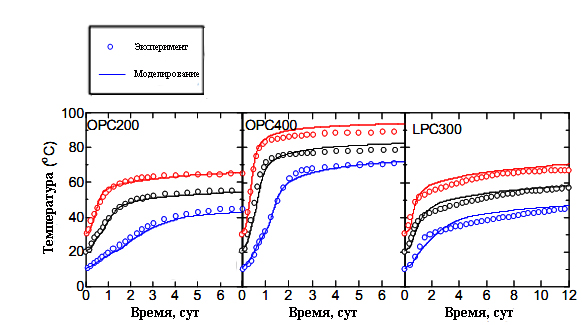
- •Числовое моделирование гидрации портландцемента
- •1.Введение
- •2.3. Влияние межчастичного взаимодействия
- •Vpore – полный объем капиллярных пор;
- •2.5. Концепция полиминеральности (сложного состава/структуры).
- •2.8. Структурные изменения гидратов
- •3. Определение параметров модели
- •4. Оценка параметров модели
- •5. Выводы/Заключение
4. Оценка параметров модели
Чтобы оценить параметры модели, определенные а предыдущей главе, экспериментальные результаты подъема экзотермической температуры были сопоставлены с результатами моделирования. При получении подъема изотермической температуры, тепловыделение бетона является суммой тепловыделений его составляющих, таких как гидраты цемента (1,20 Дж-1К-1), непрогидратирововавший цемент (0,78 Дж-1К-1), вода (4,19 Дж-1К-1), песок и заполнитель (0,85 Дж-1К-1) [20].
Свойства цемента и состав бетонной смеси приведены в Таблице 6. а результаты сопоставления/сравнения представлены на Рисунке 5. Как показано на Рисунке 5, вычислительная модель для материалов на основе цемента показывает высокий потенциал моделирования процесса гидратации, даже учитывая то, что состав цемента был вычислен по формуле Богга.
Таблица 6.
|
Состав по Боггу |
Коэф. Для функции Розина Рамлера |
Состав смеси, кг/м3 |
||||||||
C3S |
C2S |
C3A |
C4AF |
CSH2 |
b |
n |
В |
Ц |
П |
Щ |
|
OPC200 |
47 |
27 |
10 |
9 |
4 |
0,0303 |
1,1 |
157 |
200 |
862 |
1089 |
OPC400 |
47 |
27 |
10 |
9 |
4 |
0,0303 |
1,1 |
157 |
300 |
658 |
1129 |
LPC200 |
25 |
55 |
3 |
9 |
4 |
0,0263 |
1,2 |
145 |
400 |
811 |
1083 |

Рисунок 5. Сравнение моделирования подъема изотермической температуры вычислительной модели для материалов на основе цемента и результатов эксперимента.
5. Выводы/Заключение
Представлена числовая модель процесса гидратации названная «Числовая модель для материалов на основе цемента», которая учитывает распределение частиц по размерам, влияние межчастичных контактов и минеральный состав цемента. Параметры представленной модели определены из результатов эксперимента и оценены путем сравнения с экспериментальными результатами подъема изотермической температуры. Представленная модель показывает хорошие результаты в нескольких случаях, но в тоже время приемлемые ограничения данной модели должны быть уточнены с помощью дальнейших вычислений.
Ссылки/Используемая литература
[1] R. Kondo, S. Ueda, Kinetics and Mechanism of the Hydration of Cements, Fifth International Symposium on the Chemistry of Cements, Tokyo, (1968), II-4, pp.203-248
[2] F. Tomosawa, A Hydration model of cement, Proc. of Annual Meeting on Cement Technology, Cement Association of Japan, Vol.28, (1974), pp.53-57 (in Japanese)
[3] T. Knudsen, The Dispersion Model for Hydration of Portland Cement I., General Concepts, Cem Concr Res 14(5) (1984) 622-630
[4] H. M. Jennings and S. K. Johnson, Simulation of Microstructure Development During the Hydration of a Cement Compound, J Am Ceram Soc 69(11) (1986) 790-795
[5] K. van Breugel, Numerical Simulation of Hydration and Microstructural
Development in Hardening Cement-Based Material (I) Theory and (II) Application, Cem Concr Res 25(2-3) (1995) 319-331 and 522-530
[6] T. Kishi and K. Maekawa, Thermal and mechanical modeling of yound concrete based hydration process of multi-component cement mirerals, in: R. Springerschmid (Ed.), Thermal Cracking in Concrete at early Ages, (1994), pp.10-18
[7] D. P. Bentz and E. J. Garboczi, Percolation of Phases in a Three- Dimensional Cement Paste Microstructural model, Cem Concr Res 21(2-3) (1991) 325-344
[8] F. Tomosawa, Development of a Kinetic Model for Hydration of Cement, Proceedings of 10th International Congress of Chemistry of Cement, (1997) pp.2ii051
[9] G. Frigione and S. Marra, Relationship between Particle Size Distribution and Compressive Strength in Portland Cement. Cem Concr Res 6 (1976) 113-128
[10] Y. Ono, Hydraulic Activity and Equilibrium Vapor Pressure of Clinker Compounds, JCA Proceedings of Cement & Concrete 44 (1990) 24-29
[11] D. A. Palmer, R. Fernandez-Prini, A. H. Harvey, Aqueous Systems at
Elevated Temperatures and Pressures, Elsevier, London, 2004, pp. 1-29
[12] R. Badmann, N. Stockhausen, M. J. Setzer, The Statistical Thichness and the Chemical Potential of Adsorbed Water Films, J Col Int Sci 82(2) (1981) 534-542
[13] K. Uchida, Y. Fukubayashi, S. Yamashita, Effect of cement particle size on physical properties of cement paste, Proc. of Annual Meeting on Cement Technology, Cement Association Japan, 41 (1987) 62-65
[14] e.g. I. Odler, M. Ro.ler, Investigations on the relationship between porosity, structure and strength of hydrated Portland cement pastes. II. Effect of pore structure and of degree of hydration, Cem Con Res 15(3) (1985) 401-410
[15] D. Menetrier, I. Jawed, T. S. Sun, J. Skalny, ESCA and SEM studies on early C3S hydration, Cem Con Res 9(4) (1979) 473-482
[16] S. Hoshino, K. Yamada, H. Hirao, Analysis of hydration and strength development of cement containing blast furnace slag and limestone powder by using XRD/Rietveld method, Journal of Advanced Concrete Technology, 2006, (to be published)
[17] P. Stutzman, S. Leigh, NIST Technical Note 1441-Phase Composition Analysis of the NIST Reference Clinkers by Optical Microscopy and X-ray Powder Diffraction, 2002, pp.34-43
[18] R.C. Jones, C.J. Babcock, W.B. Knowlton, Estimation of the Total Amorphous Content of Hawaii Soils by Rietveld Method, Soil Science Society of America Journal, Vol64, 2000, pp.1100-1108
[19] Y. Otabe, Y Terano, Y. Suzuki, Properties of Temperature Rise of Belite Cement, JCA Proceedings of Cement & Concrete 51 (1997) 334-339
[20] I. Maruyama, T. Noguchi, T. Matsushita, Prediction of Adiabatic Temperature Rise in Portland Cement Concrete Using Computational Cement Based Material Model (in Japanese), Journal of structural and construction engineering (transactions of AIJ), 600 (2006) 1-8
